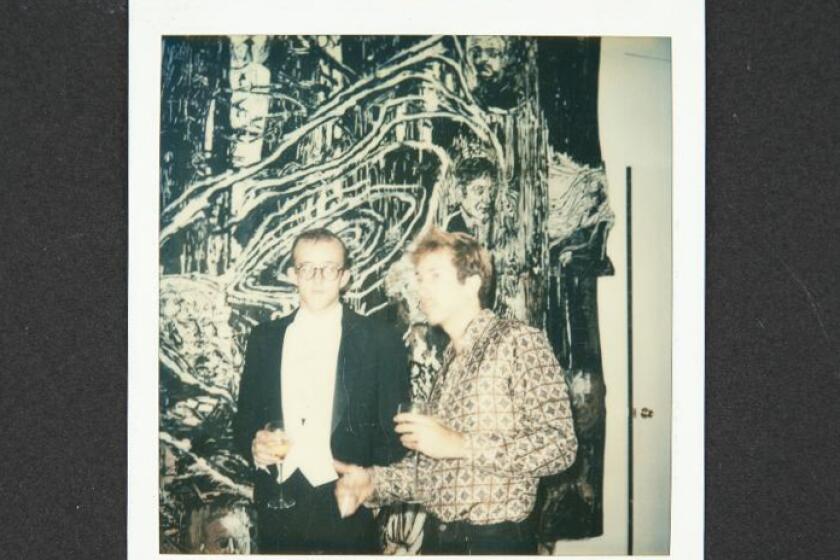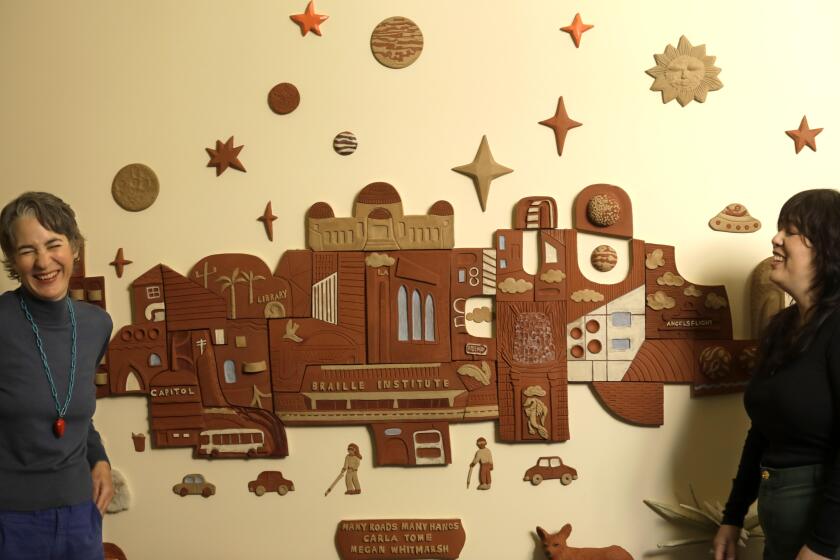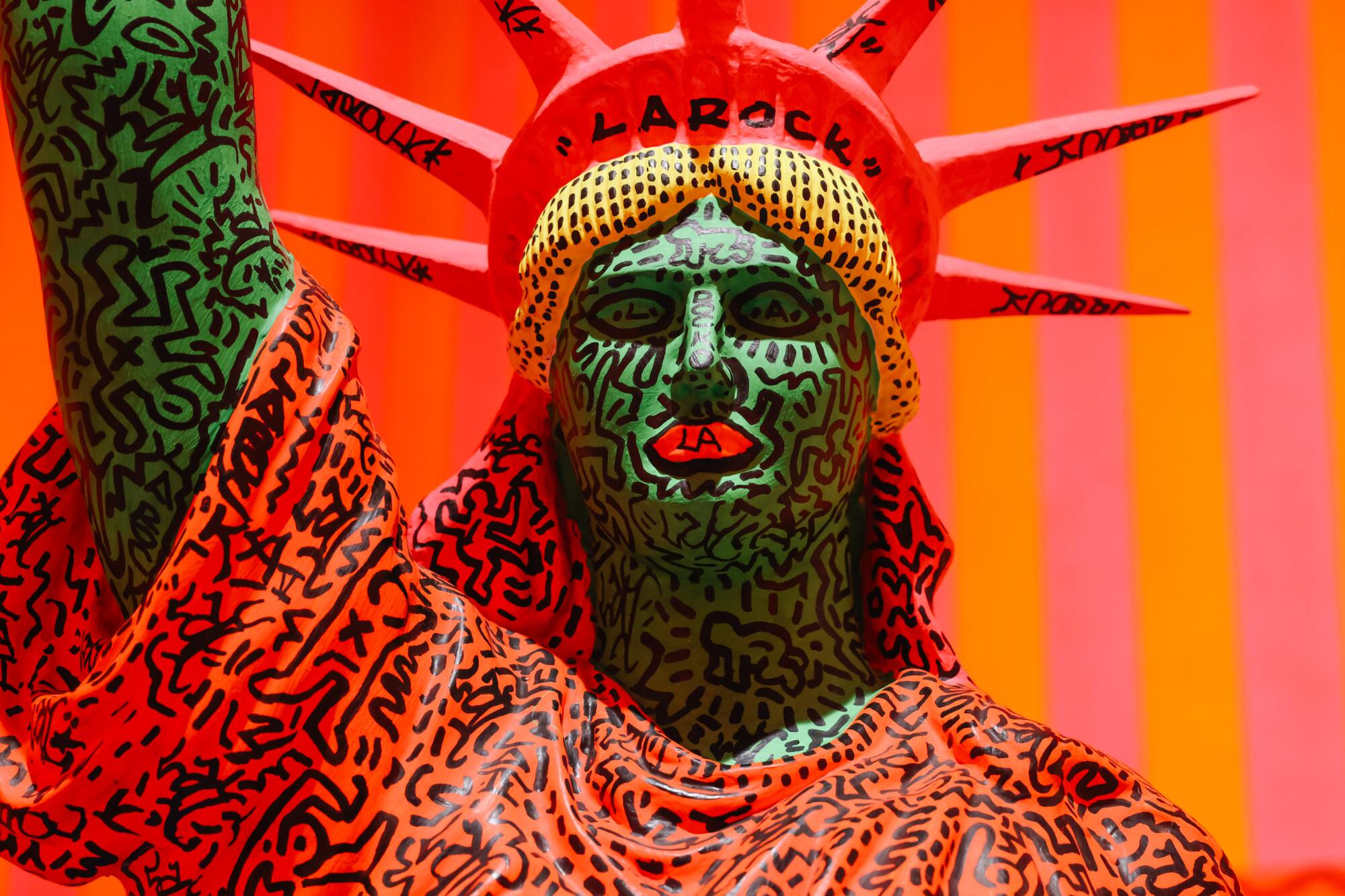
- Share via
Keith Haring climbed atop scaffolding inside a classroom building at Pasadena’s ArtCenter College of Design and began to quietly but determinedly paint. It was late November 1989, and the New York artist and activist, who was HIV positive at the time, had been invited to the college to speak to students and paint a mural on the occasion of the second World AIDS Day.
Haring popped a funk tape into his boombox, took a swig of mineral water and made his first fuchsia brush stroke on an unmarked wood panel, no pencil sketches to guide his way. A small crowd burst into applause.
Ten weeks later Haring died from complications related to the virus. His colorful, abstract mural — which still hangs opposite the library in a busy thoroughfare, as the artist had intended — was his last West Coast artwork created on his final visit to L.A.
“This mural should be here for a long time,” Haring told students and faculty in the college’s Ahmanson Auditorium after the work was completed. “And AIDS shouldn’t be.”
L.A. artist Kenny Scharf reminisces about living with close friend Keith Haring when they were students at New York’s School of Visual Arts in the early 1980s. Haring, who died in 1990, is the subject of a major Broad museum exhibition that opens Saturday.
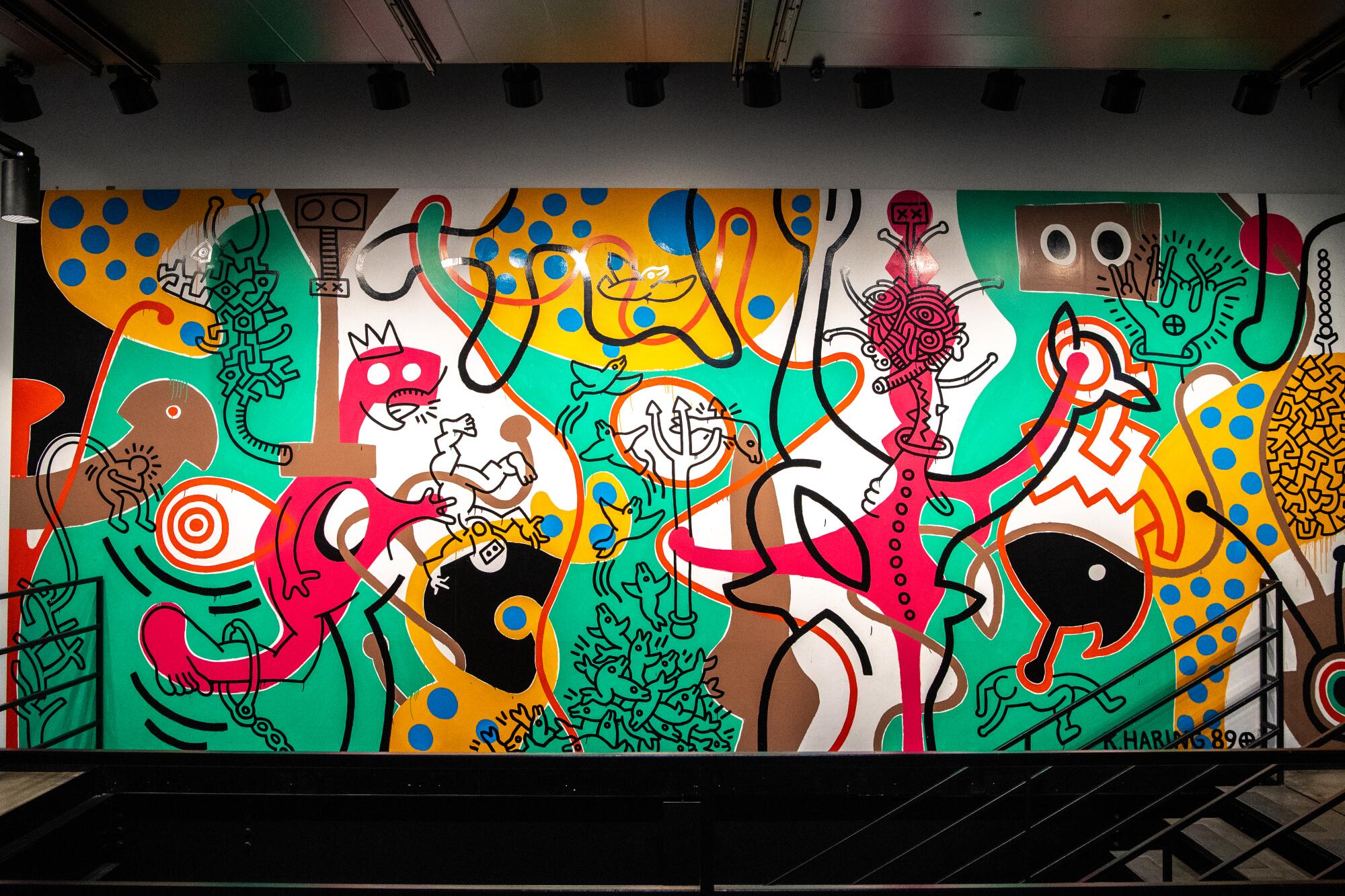
On a recent visit to the mural, one of Haring’s closest friends, L.A. artist Kenny Scharf, tears up even before our interview starts. The two were college roommates at New York’s School of Visual Arts in the early ’80s.
Scharf was by Haring’s bedside, in Manhattan, as he died. Scharf tried to calm Haring with his words. Haring couldn’t speak, or even open his eyes, but he gently squeezed Scharf’s hand to signal he was listening.
“I told him how great he was and that his art was going to live forever,” Scharf says, his eyes now bloodshot. “And that I would be there for him to talk about his work.”
Scharf points out some of the mural’s subtle — and still timely — themes, healthcare and inequity among them. “But it’s also so full of life. Just exploding with joy and energy,” Scharf says. “Like so much of his work.”
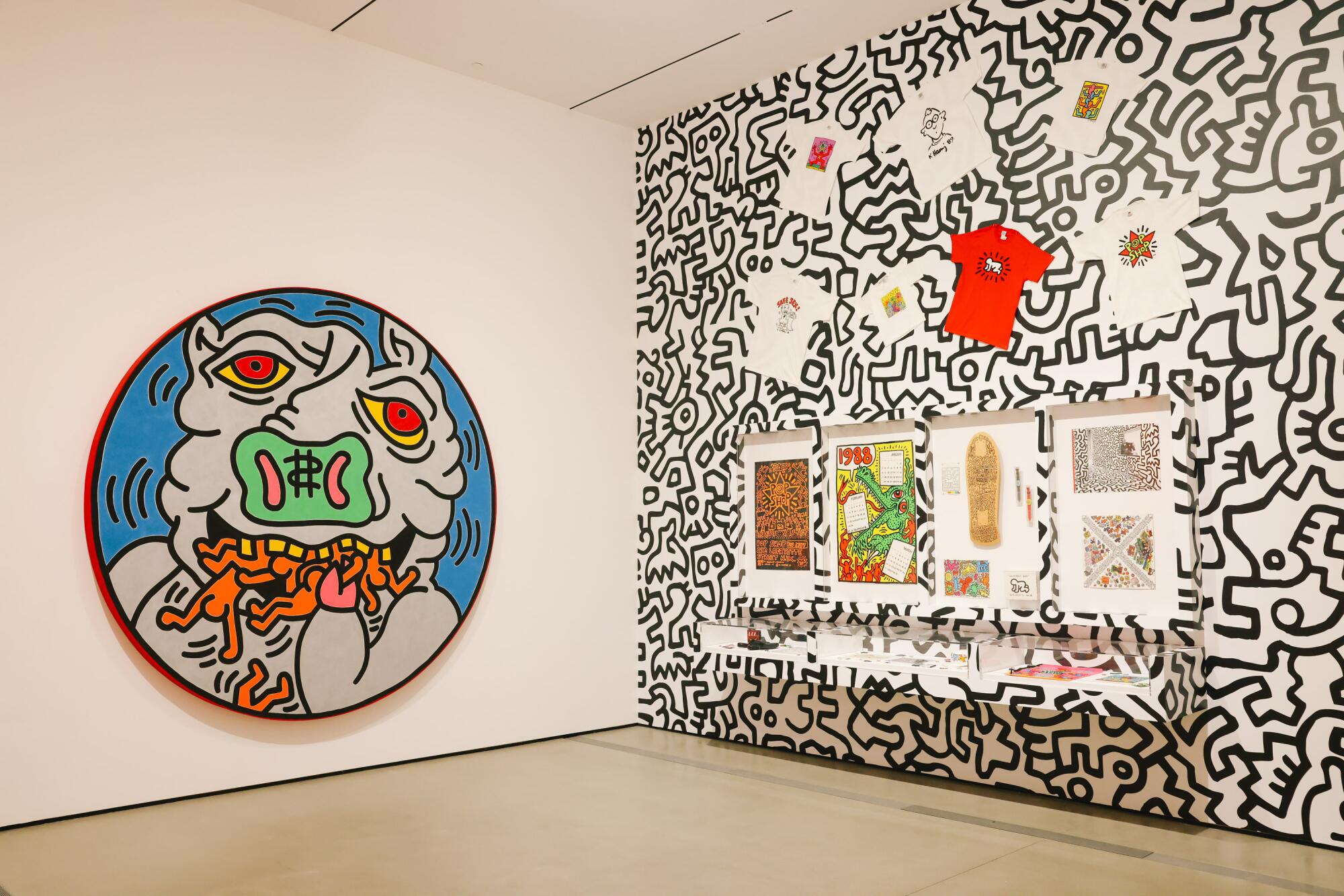
A new exhibition at the Broad museum, debuting Saturday, shines a light on Haring’s art, activism and life. “Keith Haring: Art Is for Everybody” — the artist’s first museum exhibition in L.A. — includes more than 120 works spanning 1978 through 1989 from the Broad’s collection, private lenders and other institutions. Haring’s paintings, drawings, sculptures, videos and graphic works will be on view along with documentation of his more ephemeral subway drawings and murals. The show also includes personal ephemera, most of it on loan from the New York-based Keith Haring Foundation, such as the artist’s handwritten journals and posters that he created to support activist causes and organizations. Music was integral to Haring’s practice and his mixed tapes play in some of the galleries.
Haring had a solo exhibition at L.A.’s Michael Kohn Gallery in 1988 and his sculptures showed at the Pacific Design Center in 1999. But the fact that he hasn’t had an institutional survey in L.A. until now is surprising, especially considering how commercially ubiquitous his bright, animated imagery is, seen on T-shirts, mugs, rugs and elsewhere. Perhaps it’s because he was seen as such a quintessentially New York artist or that his roots as a street artist, and the commercial and stylistic accessibility of his work, hindered him being seen as a more serious artist in an art world that prized exclusivity.
But one thing is certain, says Broad Director Joanne Heyler: The time is exactly right for a Haring exhibition to finally debut.
“When you look at what Keith Haring’s concerns were and what he attempted to do and say through his art and personal activism — AIDS awareness, his critique of capitalism, his critique of global social justice issues that focused on South Africa and apartheid, his critique of what, in the ’80s, was called consumerism or commodification — he was looking for change. And there are many calls for change, on many fronts, in our times today.”
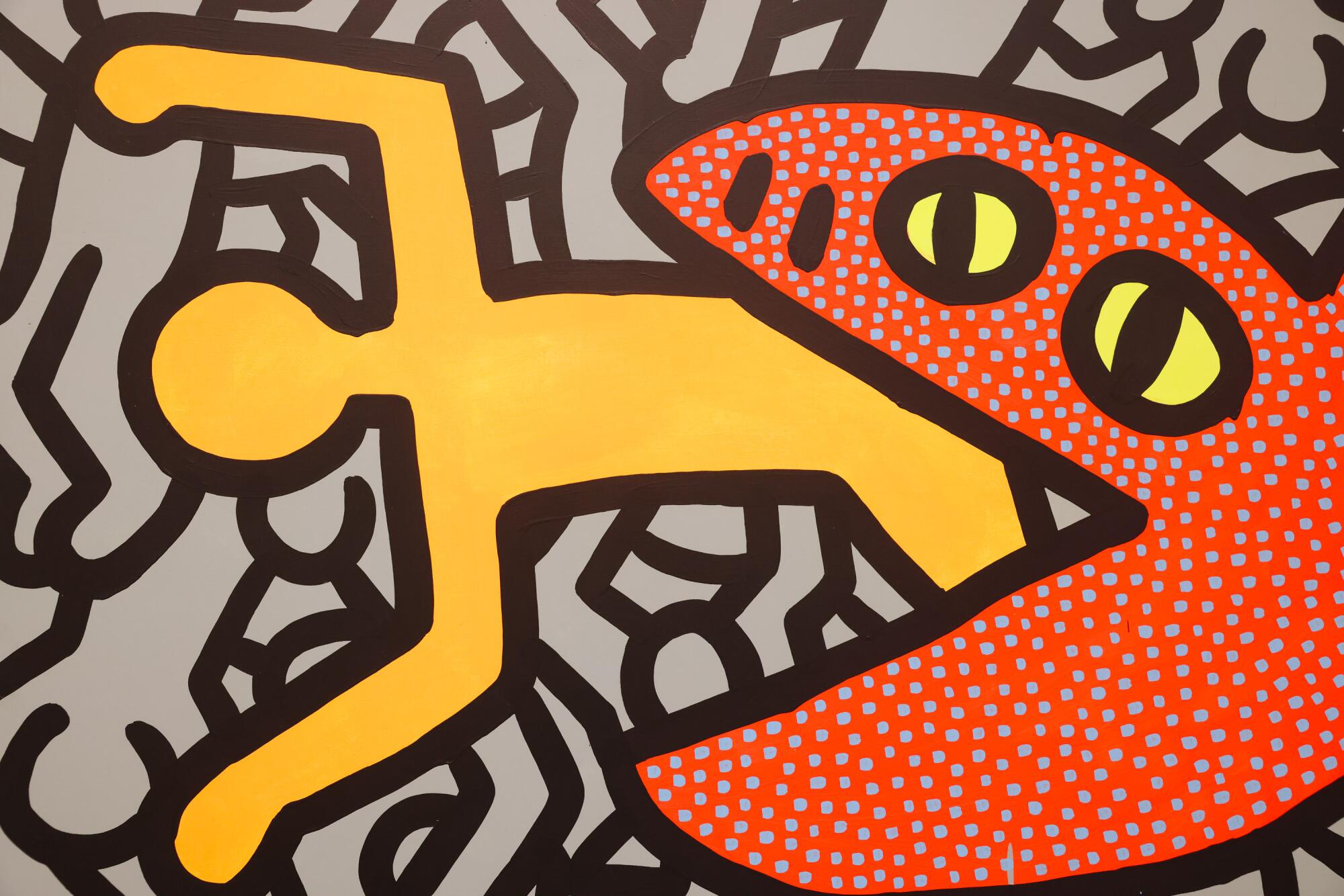
Broad museum visitors will likely recognize Haring’s colorful, kinetic images of barking dogs, dancing figures, flying saucers and crawling babies, but may not be aware of the depth behind them, Heyler says. The exhibition, organized by Broad curator Sarah Loyer, aims to deepen the public’s understanding of the artist.
“There’s a large audience that will only be familiar with the tip of the iceberg,” Loyer says, “and will really be surprised by the breadth of work they’re seeing and the topics he takes on — topics we’re still struggling with as a society today.
Haring made neon-bright, energetic and whimsical works that reflected his love of music, dance and the downtown club scene he was so much a part of, while also making art that gave voice to serious social and political issues. Individual works often reflected both, with the surface joie de vivre belying much darker ideas. His visual language of now-iconic imagery created a throughline across all of his work, whether in galleries, inside subway tunnels or on T-shirts.
A central concern of Haring’s was accessibility to art. The Broad exhibition’s title comes from a quote Haring wrote in his journal when he was 20, that it’s “the responsibility of a ‘self-proclaimed artist’ to realize the public needs art, and not to make bourgeois art for the few and ignore the masses.” Haring, a kid from Kutztown, Pa., came out of New York‘s street art scene. Shortly after arriving in Manhattan in 1978 to attend the School of Visual Arts, he began making subway drawings on black paper that covered expired billboard ad spaces so that passersby, from all walks of life, would see them. He created posters and logos for activist events, mentored school children in conjunction with his art exhibitions and offered more affordable versions of his imagery in his SoHo Pop Shop, on buttons, posters, magnets and hats.
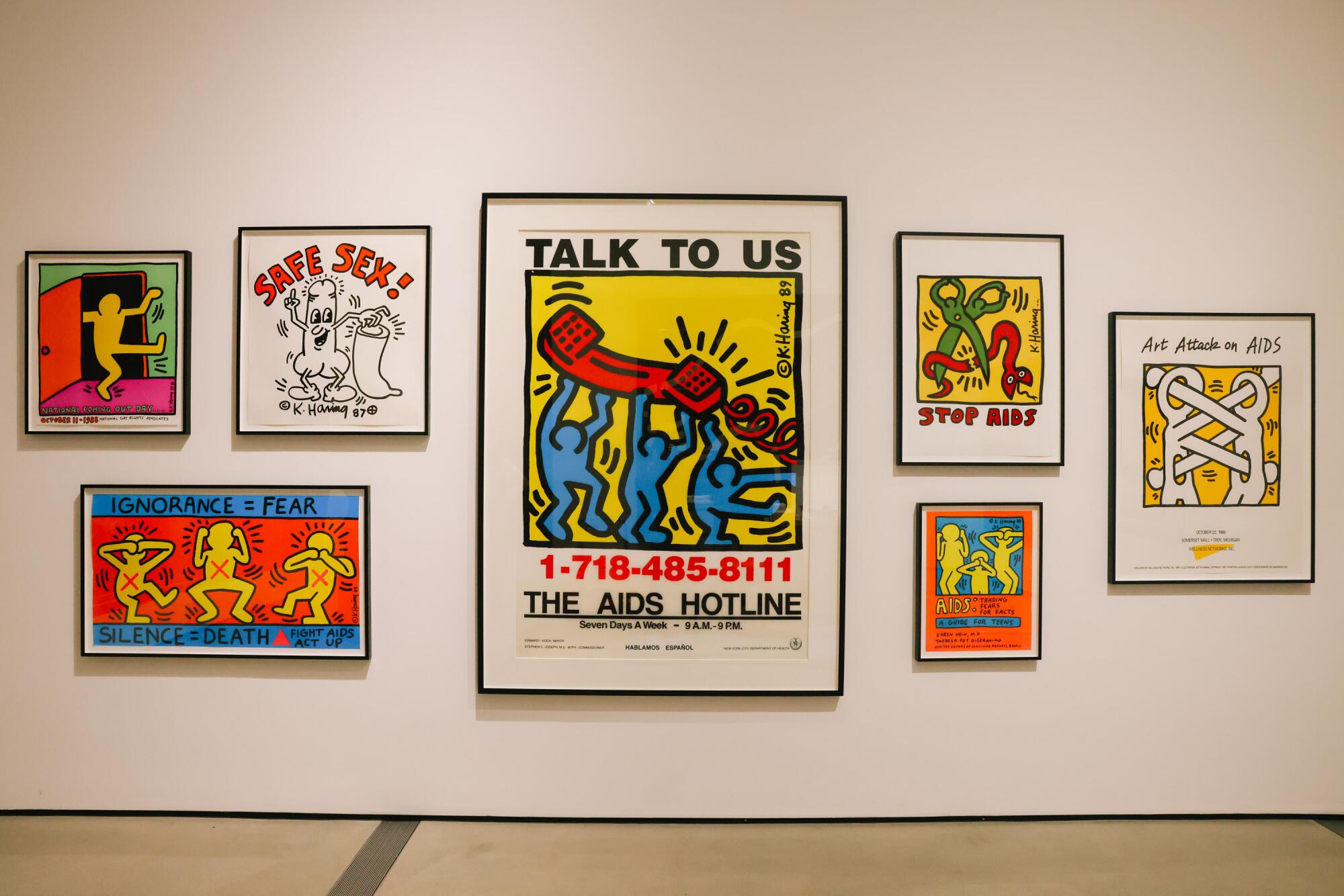
On May 9, the Getty announced the next edition of Pacific Standard Time, as well as a rebrand and project updates. The SoCal-wide multidisciplinary arts initiative, debuting in September 2024, will blend art and science.
Gallerist Michael Kohn says he’d ride the subway to New York University in 1981 and glimpse Haring through the window rapidly making chalk drawings of baby figures. The performative gesture was as much about sparking joy in passersby as spreading his images to the public for free.
“By that time he was a folk hero, people loved him,” Kohn says. “It became a thing — where was Keith Haring going to do his thing next?”
Haring didn’t make many trips to L.A. But his few visits were memorable, says Gil Vazquez, his friend, and president and executive director of the Keith Haring Foundation.
In July 1989, Haring traveled to L.A. to help install his sculpture at gallerist Martin Blinder’s home and Vazquez tagged along.
They visited friends Dennis Hopper, Pee-wee Herman, Madonna and Warren Beatty on that trip along with Timothy Leary. They spent the afternoon at Leary’s eating pot brownies and analyzing how, in the future, computers might affect art-making.
Despite traveling in such famous circles, Vazquez says, Haring remained grounded. “The common thread is Keith wanting to be of service to his fellow humans,” Vazquez says. “And wanting to leverage his fame to do good. His generosity.”
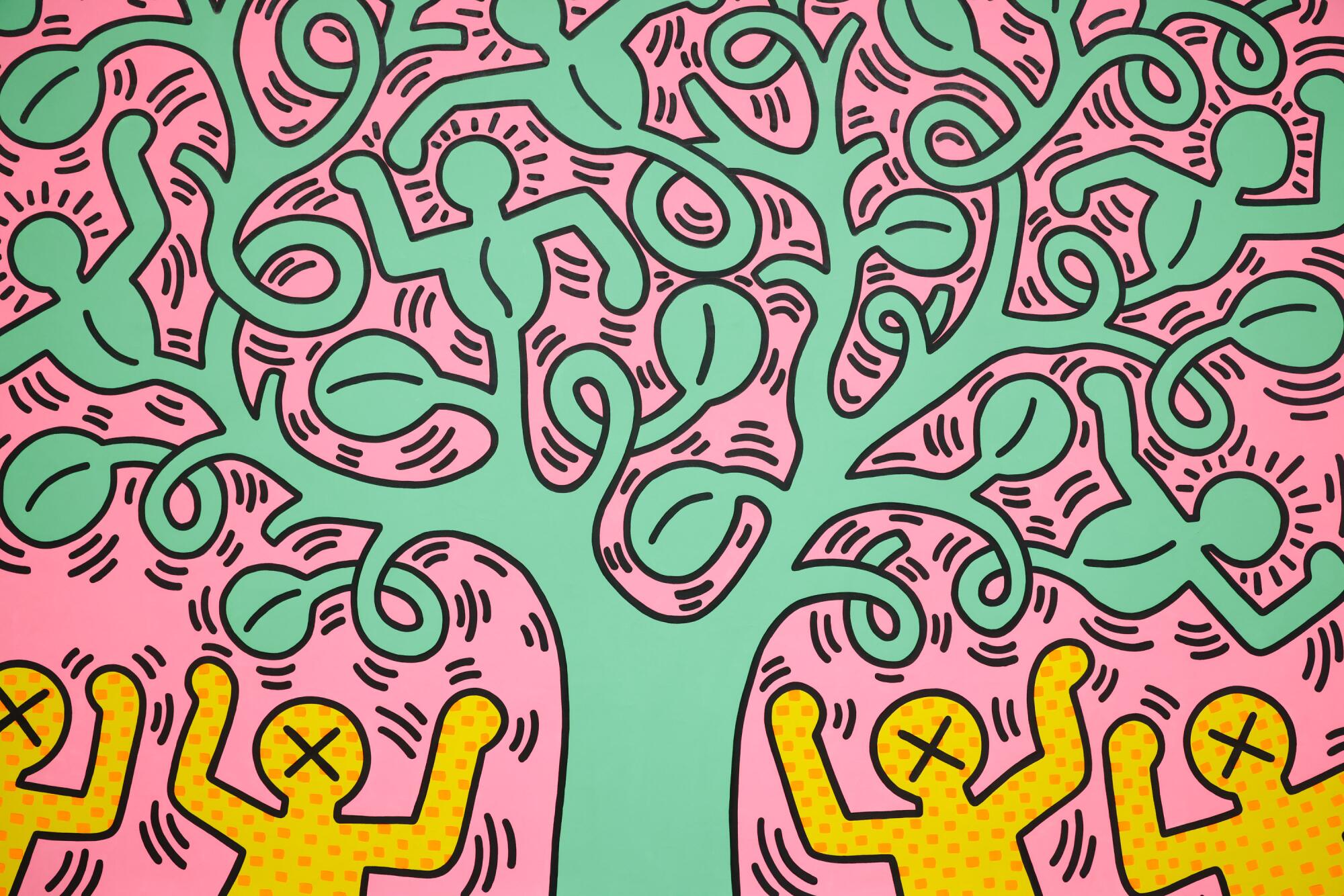
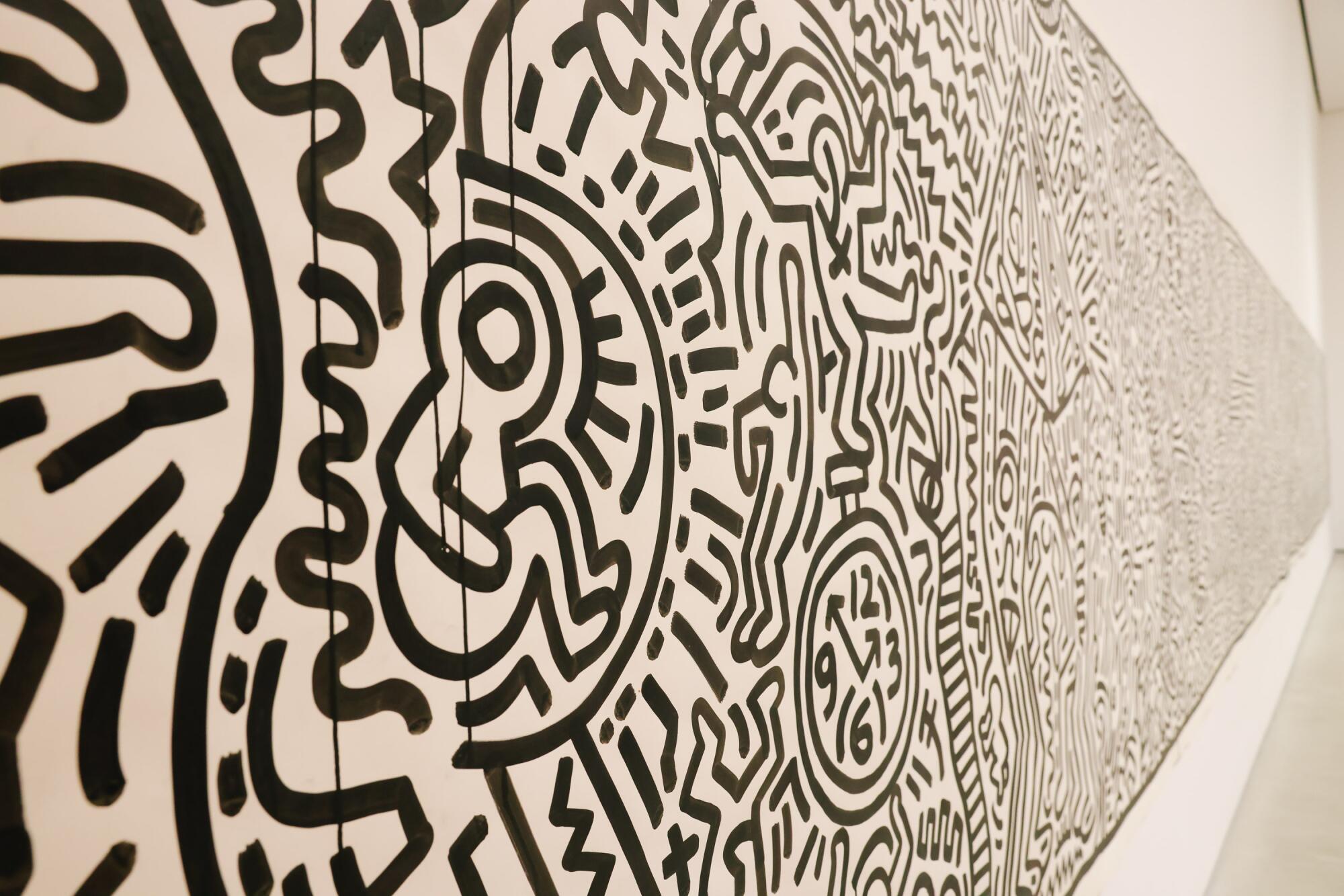
“Art Is for Everybody,” which fills nine ground-floor galleries, has special significance for the Broad: it’s a show that reflects the roots of the museum’s collection. The Broads were fascinated with the ’80s Lower Manhattan art scene. They bought works by Jean-Michel Basquiat, George Condo and Scharf at the time and acquired all eight Haring works in their collection while the artist was still alive.
The exhibition kicks off energetically. In 1982, Haring had his first major gallery show at New York’s Tony Shafrazi Gallery — it featured, among other things, DayGlo works in a UV-lit basement. An immersive space at the Broad, wrapped in similar screaming-bright, striped wallpaper from that show, features five of Haring’s DayGlo paintings along with several sculptures. (The room will not be UV-lit to protect the works.) One sculpture, a towering Statue of Liberty holding a black lightbulb, was a collaboration with graffiti artist LA II (Angel Ortiz). A mix of hip-hop, house, funk and ’80s pop, from Haring’s mixtapes, will play in the gallery.
The Braille Institute Los Angeles debuts its new Library for the Blind and Visually Impaired on April 26. We get a first look at its L.A. cityscape sensory wall and mural.
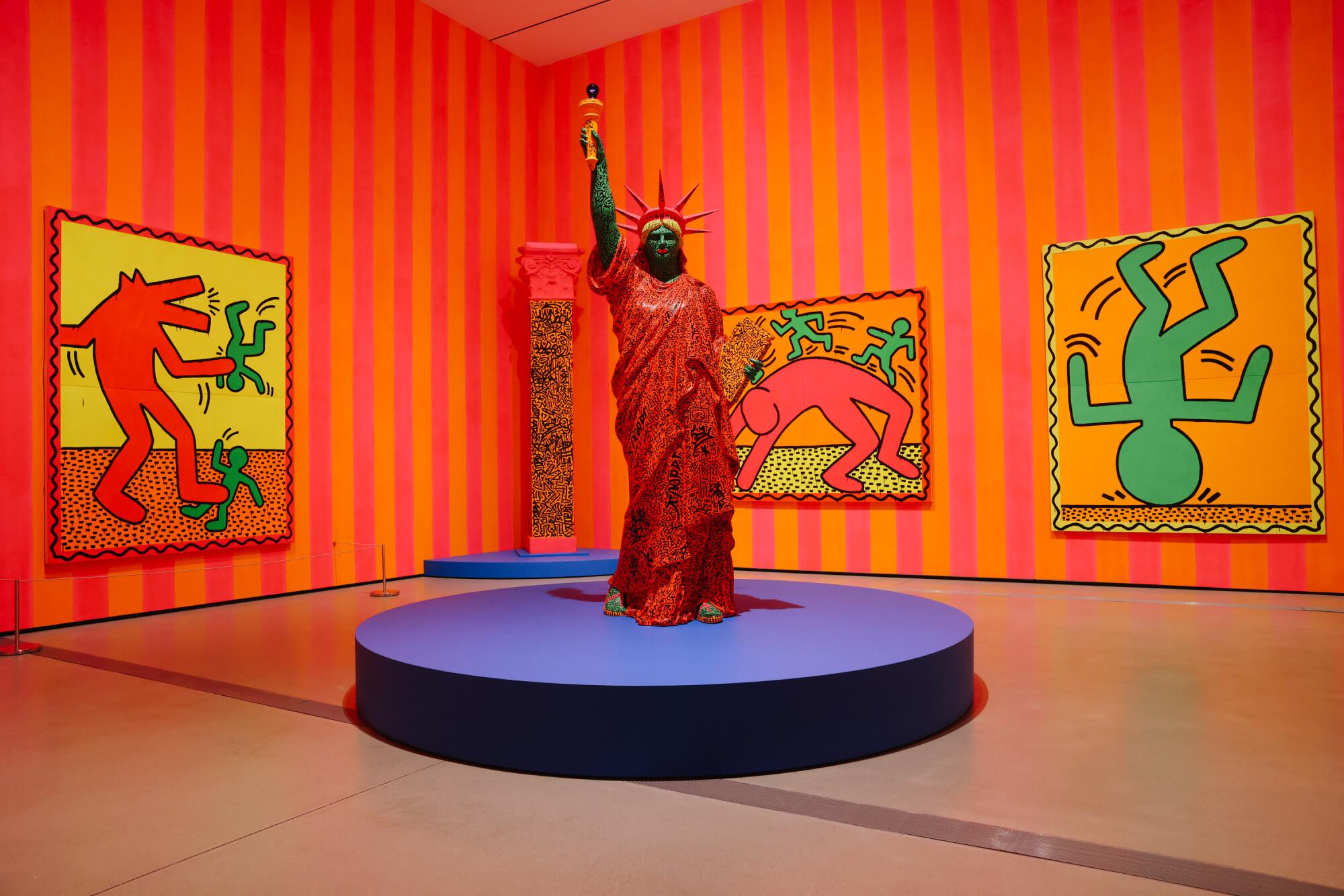
Haring’s early student work from 1978-80, around the time he came out as gay, is on view nearby. His concerns at the time are evident: sexuality, animal rights and environmentalism. Early versions of Haring’s barking dogs, radiant babies, pyramids and nuclear towers show up here — he was also thinking about language and developing a visual lexicon — along with videos he made, including “Painting Myself Into a Corner,” in which he paints an abstract design onto the floor while inching backward.
Another section, featuring later work, concerns itself with “mortality and morality,” Loyer says. A large-scale, blood-red and black painting from 1985 addresses the AIDS epidemic; paintings Haring made after his first trip to Japan in 1983 take on the effects of nuclear war; other works explore religion.
“He was thinking more critically about the Christian right at that time,” Loyer says, “and the response to the AIDS epidemic and abuses of power and moralizing around that and other issues.”
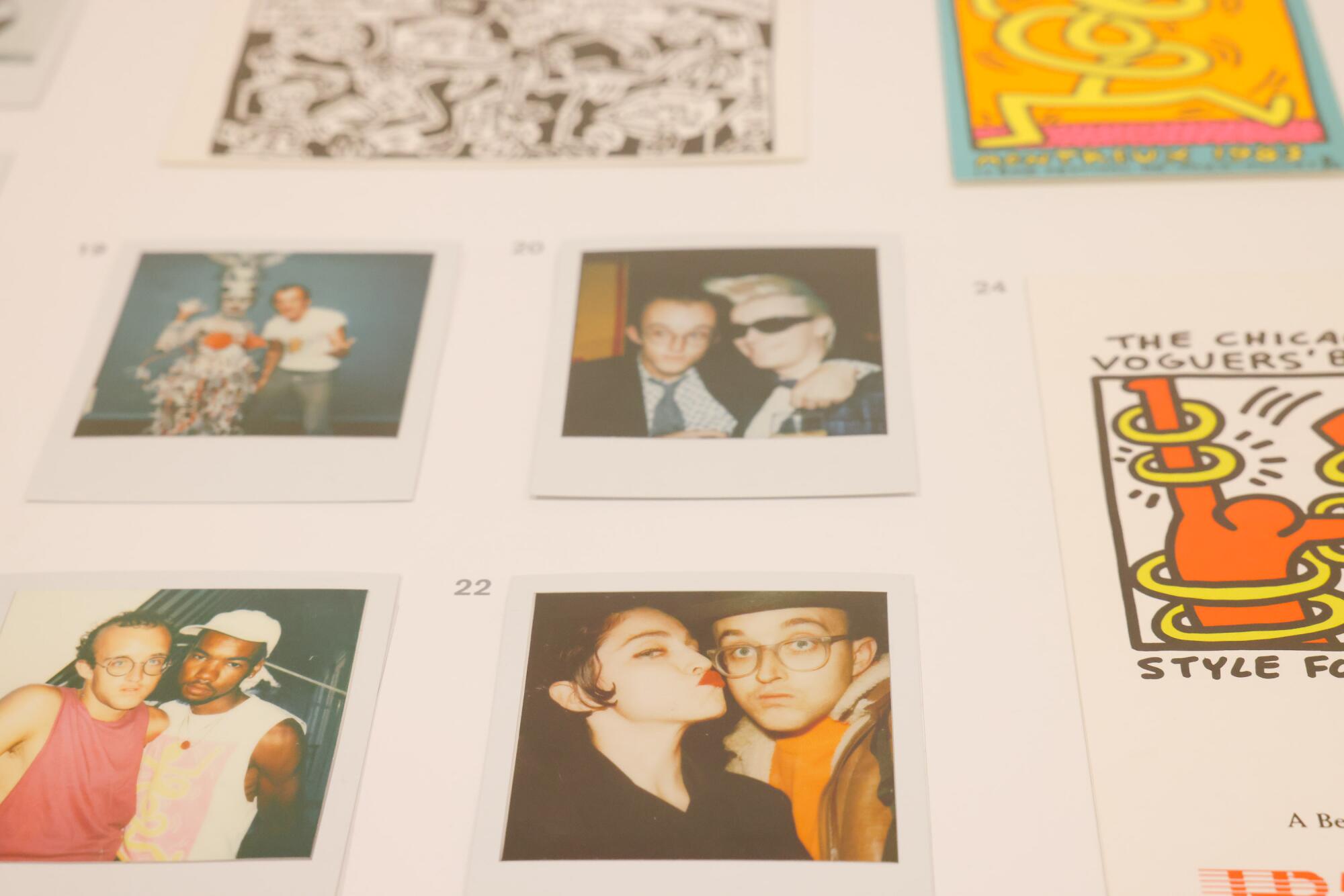
Haring thrived in creative communities. He curated group art shows at Club 57 and other venues when he was a student, looked to Andy Warhol as a mentor and partied with Madonna, Basquiat, Grace Jones and Boy George.
One gallery is inspired by the downtown club scene and Haring’s prolific collaborations with other artists. The pink leather suit Madonna wore to Haring’s birthday party at the Paradise Garage in 1984, a collaboration with LA II, is on view along with the headpiece Jones performed in, a Haring collaboration with jewelry designer David Spada. There’s also a set piece — a tent — that Haring made for choreographer Bill T. Jones’ 1984 production, “Secret Pastures.”
Haring emerged alongside the advent of hip-hop and incorporated images of boomboxes and break dancers into his work. Several of his paintings are named after Public Enemy songs. On June 20 at the Colburn School — part of the Broad’s lineup of talks, club nights and performances around the exhibition — Public Enemy’s Chuck D will appear in conversation with Vazquez; Basquiat’s sister, Lisane Basquiat; and Channel Zero Productions’ Lorrie Boula to discuss hip-hop and the ’80s culture scene.
“Art Is for Everybody” travels to Toronto’s Art Gallery of Ontario in the fall before heading to the Walker Art Center in Minneapolis next year.
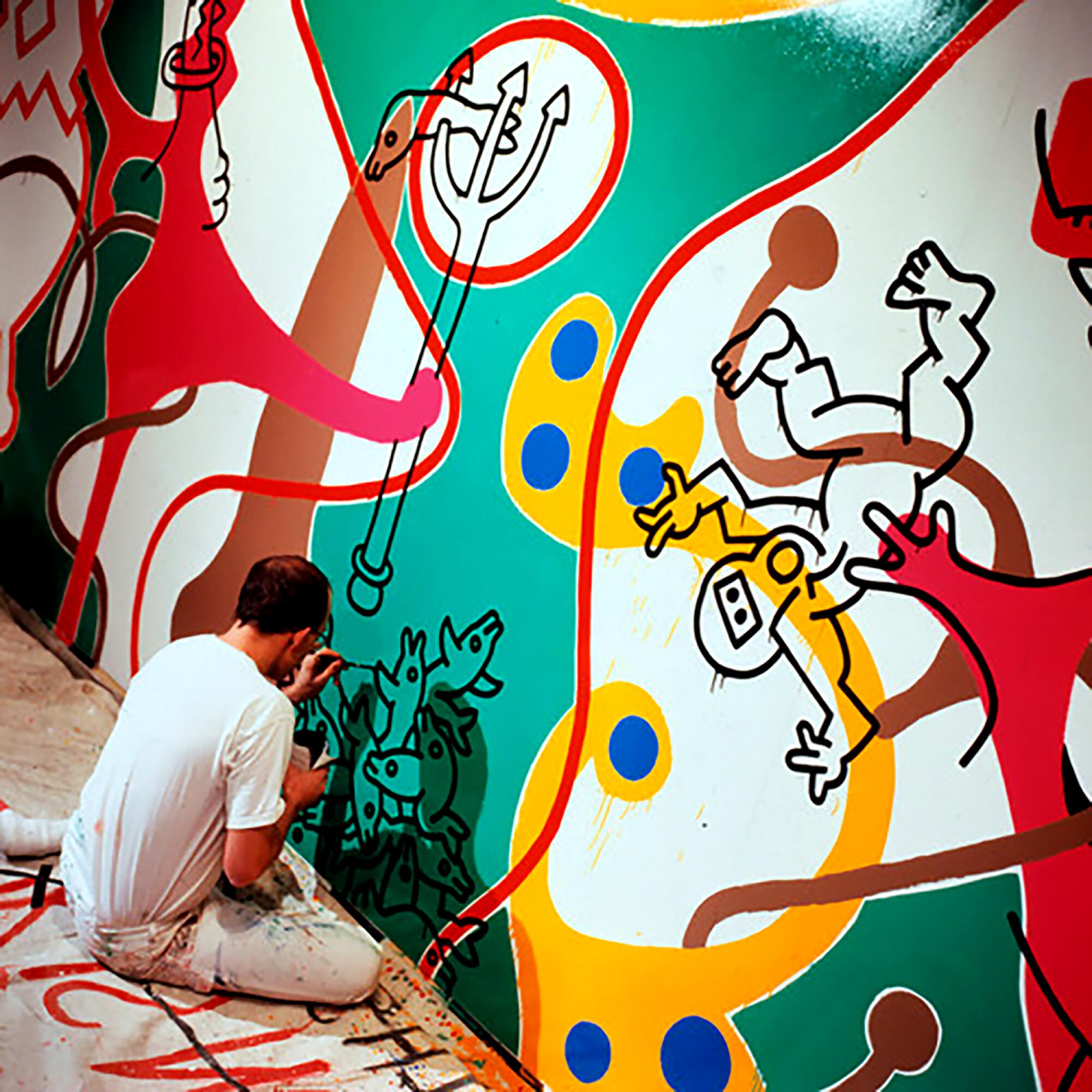
Haring was a self-described workaholic who produced an exceedingly robust body of work in about a decade. And he took creative risks until the very end.
Back in 1989, when Haring painted the ArtCenter mural, artist Doug Aitken was a student at the college. He assisted Haring on the work.
Given the AIDS epidemic at the time, Aitken says, there was a sense of “urgency and mortality in the air” when Haring painted the work, but also a feeling of bravery and experimentation.
“If you look at his work in general, it’s very symmetrical and pattern-based,” Aitken says. “And I always found that mural to be unique because it’s asymmetrical, these shapes of different scales.
“That always struck me. That you’d come to the end of your life, and you’re at this point in your career, and there’s a sense of closure. And yet, he’s evolving, changing, he’s pushing towards something new.”
'Keith Haring: Art Is for Everybody'
Where: The Broad, 221 S Grand Ave., L.A.
When: May 27-Oct. 8; see website for times
Cost: Adult general admission, $22
Info: thebroad.org
More to Read
The biggest entertainment stories
Get our big stories about Hollywood, film, television, music, arts, culture and more right in your inbox as soon as they publish.
You may occasionally receive promotional content from the Los Angeles Times.
